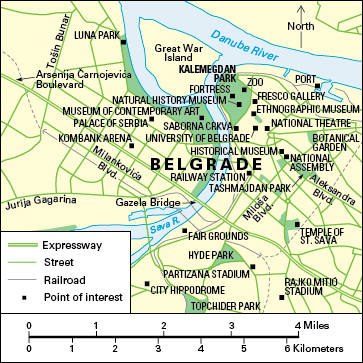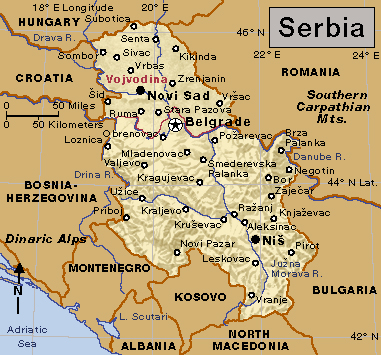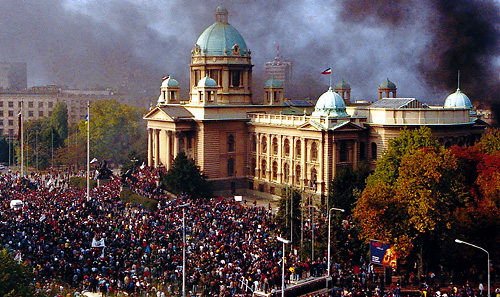Belgrade << BEHL grayd or behl GRAYD >> (pop. 1,197,714) is the capital and largest city of Serbia. The municipality of Belgrade has a population of 1,681,405. A municipality may include rural areas as well as the urban center. Belgrade’s name in the Serbian language is Beograd. The city serves as a major river port and railroad center. It lies in north-central Serbia, at the junction of the Danube and Sava rivers. Belgrade has been at the center of political and military struggles for thousands of years.

The city
covers about 71 square miles (184 square kilometers). The most modern section, known as New Belgrade, is on the west bank of the Sava River. The oldest section, known as Stari Grad (Old City), lies on a hill that overlooks the junction of the Sava and the Danube.

Belgrade has a number of museums, including the Ethnographic Museum and the Fresco Gallery. Theaters in Belgrade present ballets, concerts, plays, and operas. Many parks, including Kalemegdan, Tashmajdan, and Topchider, dot the city. The University of Belgrade developed out of a school founded in 1808. The Temple of St. Sava, a Serbian Orthodox church, is one of the city’s major cultural attractions.
People.
Most of Belgrade’s people are Serbs, but the population also includes Albanians, Hungarians, Montenegrins, and other groups. The majority of the people use the Serbian language. Most of the Serbs belong to the Eastern Orthodox Church.
Economy.
The government employs a large number of people in Belgrade, and many others work in banking or commerce. Products made by Belgrade’s industries include automobiles, electrical equipment, farm machinery, flour, paper, shoes, sugar, and woolen textiles.
History.
People lived in the vicinity of what is now Belgrade as long ago as 5000 B.C. During the 300’s B.C., Celtic tribes settled in the area. The Romans later captured the settlement, which they called Singidunum, and it developed into a city.

In A.D. 441, the Huns destroyed Singidunum. Over the next 1,000 years, invading armies conquered and destroyed the city dozens of times. Slavic tribes captured the city around 600 and later renamed it Beograd. Control of the city shifted frequently between the Hungarians, the Byzantine Empire, and others.
In 1403, Belgrade became the capital of the Serbian kingdom. The Ottoman Empire, centered in what is now Turkey, captured the city in 1521. The Ottoman and Austrian empires battled during the 1600’s and 1700’s, and Belgrade changed hands between them several times.
During the 1800’s, Belgrade was a center of revolutionary activity by Serbian nationalists fighting for Serbia’s independence from Ottoman rule. Serbia won complete independence from the Ottoman Empire in 1878, and Belgrade remained the country’s capital.
Austro-Hungarian and German forces occupied Belgrade during World War I (1914-1918). In 1919, the city became the capital of the newly created Kingdom of the Serbs, Croats, and Slovenes, which was later renamed Yugoslavia. The Germans occupied Belgrade during most of World War II (1939-1945). Yugoslav Communists freed Belgrade in 1944 and gained control of the country at the end of the war.
Belgrade grew rapidly in the mid-1900’s. The city experienced a housing shortage and built many apartment buildings. Serious air pollution developed from cars, factories, and homes heated by coal fire.
As Yugoslavia broke up in the 1990’s, Belgrade experienced much unrest. Montenegro and Serbia formed a new Yugoslavia, later changing the name of the country to Serbia and Montenegro. In 1999, the North Atlantic Treaty Organization (NATO) bombed targets in Belgrade while trying to enforce a peace settlement. In 2000, protests in Belgrade helped lead to the resignation of Yugoslav President Slobodan Milosevic. In 2006, Serbia and Montenegro separated and became independent countries.


See also Serbia; Yugoslavia.
